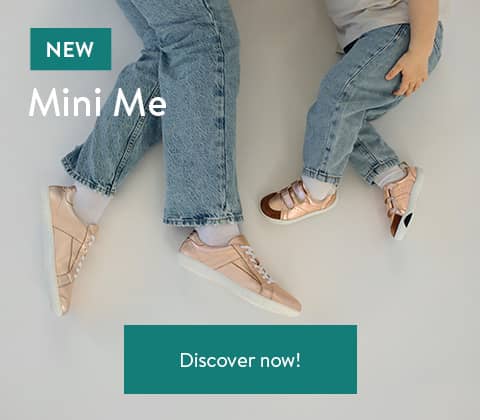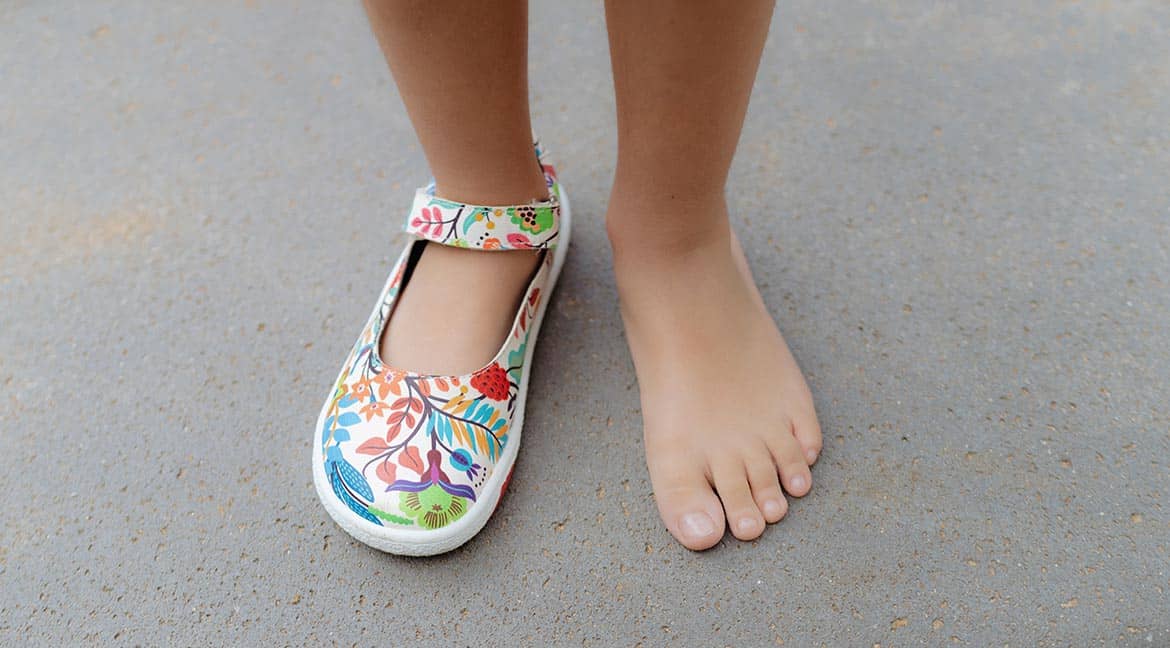Foot deformity in children
When a child is diagnosed with a foot deformity, parents are often faced with lots of questions. But there is no immediate cause for concern. That is because foot deformities are common and often innocuous, both from birth and up to pre-school age. We provide an insight into potential foot deformities in children, examining the causes and describing what can be done.
When a child is born, the musculature in their small feet is not yet fully developed. As a result, deformities in the feet are not uncommon. But feet deformities can also develop when the child is learning to walk. If these issues are recognised and treated early, it is usually possible to correct a young child's feet using non-invasive techniques. Parents can also do a lot to facilitate the healthy development of their children's feet.
Childhood foot deformity — what are the causes?
There are a wide range of foot deformities that can affect babies and toddlers. Some are congenital, which means they either have a genetic origin or they developed due to the feet being held in a particular position in the womb. These kinds of incorrect alignments affecting the unborn child are the result of the restricted space in the womb. On the other hand, foot deformities can be acquired later, for example due to insufficient exercise, incorrect footwear or childhood obesity. If a childhood foot deformity is left untreated or not tackled correctly, it can become more pronounced and cause excessive strain on the knees, hips and spine. However, certain types of foot deformity may simply resolve over time. It is important for parents to take deformities in children's feet seriously and to consult a paediatrician or orthopaedic expert at an early stage.
What foot deformities are found in children?
Foot deformities in children are usually visible to the naked eye and can be diagnosed through routine screening by a paediatrician. X-ray examinations should be avoided as far as possible, particularly for babies and young children. In the following sections, we give an introduction to specific childhood foot deformities.
Foot deformities in children #1 — flat feet
One of the most common childhood foot deformities is the flat foot. This is usually an unproblematic and expected phase of childhood development. There is a smooth transition to the flexible flat foot. While babies are born with bowlegs, the position of the legs only becomes increasingly X-shaped as the toddler makes their first attempts to stand and walk. This causes the longitudinal arch of the foot to sink (flat foot) and the heel to bend inwards. If the entire sole of the foot makes contact with the ground, this is called a flat foot. This type of childhood foot alignment is very natural up to a certain age because the longitudinal arch of the foot is not yet fully formed. Paediatric flat feet are a natural developmental stage as the child learns to walk. In general, the foot will acquire a normal arched shape as the child reaches the age of six. The only exception to this is where there is an extreme deformity or congenital flat feet, where further treatment (surgery or use of orthotics) is required.
Foot deformities in children #2 — talipes calcaneus (a type of clubfoot)
This foot deformity is widespread in children. For example, many babies are born with a foot that is misaligned in this way but that resolves within the first few days. This deformity involves a foot that is bent upwards, while the sole of the foot points outwards. When walking, only the heel touches the ground, in part due to the lack of calf muscles. If the condition is less pronounced, the forefoot may be on the ground but unable to be loaded properly. Where the deformity is pronounced, the back of the foot may even reach the shin. This particular foot alignment has a significant impact on gait, which in turn means other parts of the body — including knees, hips and pelvis — are forced into an unnatural position. In children, this is usually a congenital foot deformity, which can either be the result of hereditary risk factors or a constrained position in the womb. The condition can also be acquired subsequently, in which case the cause will be nerve or tendon damage, for example as the result of an accident or operation. Treatment options include both physiotherapy and targeted foot exercises, but an orthotic may also be recommended to realign the foot into the correct position.
Foot deformities in children #3 — in-toeing (or pigeon toes)
Pigeon toes are a particularly common foot misalignment in children. The inward rotation of the forefoot causes the whole foot to acquire the shape of a half-moon. The heel may either be unaffected or tilted inwards. In-toeing usually occurs on both sides. Although this foot misalignment does not cause pain, it often results in a gait that is severely twisted inwards. As well as a hereditary predisposition, this condition often develops in the final week of pregnancy. The reason for this is lack of space in the womb, which causes the foetus to lie in a twisted position. In-toeing is usually harmless in children and something that naturally corrects as the child grows. If the misalignment does not go away of its own accord, conservative (i.e. non-surgical) treatment options such as stretching exercises and orthotics are used.
Foot deformities in children #4 — talipes equinus
A child affected by talipes equinus will literally walk on tiptoe due to the fact that the heel cannot be placed on the ground. Because the rolling action of the foot is inhibited, the entire body weight rests on the front foot both when standing and walking. This is not usually a congenital foot deformity in children. The cause is usually a disease that affects the nervous system, and consequently the foot muscles. The unusual foot position also leads to a shortening of the Achilles tendon, which can result in a significant functional disorder affecting the entire leg. The most common cause of talipes equinus in childhood is an underlying neurological disease, including spastic paralysis. The distinctive pointed toe alignment may occur in isolation or in combination with other foot deformities, including clubfoot, a high arch or flat foot. In children, the condition is treated with special stretching exercises, plaster casts and orthopaedic inserts before surgery is considered.
Foot deformities in children #5 — clubfoot
In children, a distinction is made between idiopathic clubfoot and neurogenic clubfoot. Idiopathic clubfoot is one of the most common congenital foot deformities in children. This is a complex deformity of the foot that is associated with a bony change, muscular imbalance and joint deformities, resulting in limited foot mobility. Neurogenic clubfoot, on the other hand, is acquired and usually caused by disruption to the nerve system, potentially as the result of an injury or infection. The preferred treatment for clubfoot in a child is to use plaster casts or tape to correct the position of the feet. If the clubfoot is corrected soon after birth, no surgical intervention is usually necessary. The Ponseti technique has proved particularly effective for babies and involves correcting the clubfeet by using special plaster casts. Complex surgery is usually only resorted to if the condition is very severe. This may involve lengthening the Achilles tendon.
How would I recognise a foot deformity in my child?
In general, a childhood foot deformity will be visible to the naked eye. The diagnostic process used by a paediatrician or orthopaedist will involve examining the child's feet while they are walking, standing and lying down. If a foot deformity is suspected in a child, particular attention is paid to the young patient's gait pattern. If a gait abnormality or deformed shape is identified, appropriate therapy will be offered to correct the child's feet. Treatment of a childhood foot deformity may involve both a conservative (non-surgical) and surgical approach, however, surgical interventions are only used for very severe foot disorders. Most foot deformities in children can be treated with targeted therapies, including physiotherapy, stretching exercises, orthopaedic shoes, insoles, plaster casts or orthotics.
What parents can do to prevent foot deformities in their child
The key thing to remember for healthy childhood foot development is that shoes must be flexible and comfortable. It is essential for the foot to have sufficient space in the shoe to enable healthy and resilient growth. The development of the child's foot musculature is particularly important, which means children should be allowed to romp about and run barefoot as much as possible, ideally on different surfaces such as grass, sand, and even to some extent forest floor. However, especially in public areas, parents should make sure there are no sharp objects on the ground that could injure the child. Since children cannot always go barefoot, especially at certain times of the year, barefoot shoes for children can be a great alternative. You can find out more about foot health in our article Barefoot shoes for foot deformities.
Exercises to strengthen children’s foot muscles
Conditions affecting children's feet can be prevented and treated through special exercises to strengthen the foot muscles. A simple example of this kind of exercise might be grasping objects using a bare foot (a pen, piece of paper, cloth, or toilet roll, etc.). Barefoot rope skipping can be a great workout for the feet, especially for older children, because the repeated pushing off and cushioning action helps exercise the foot muscles. A fun activity to do together is to try drawing using a pencil held between the toes.
Healthy footwear for children — barefoot shoes for kids
Barefoot shoes are a great alternative to conventional footwear to promote healthy foot development in children. Our Groundies barefoot shoes for kids have a flexible sole, which strengthens and moves the tendons, joints and muscles of the foot. This supports the child's natural gait, just like barefoot walking, but with the difference that little feet are protected against rough asphalt, sharp objects and little stones.















